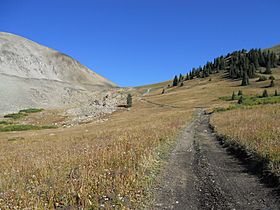Napoleon Pass facts for kids
Quick facts for kids Napoleon Pass |
|
|---|---|

Napoleon Pass
|
|
| Elevation | 12,034 ft (3,668 m) |
| Traversed by | Forest Trail 540 |
| Location | Gunnison County, Colorado, U.S. |
| Range | Sawatch Range |
| Coordinates | 38°41′56″N 106°27′37″W / 38.6988840°N 106.4603048°W |
| Topo map | Cumberland Pass |
Napoleon Pass is a very high mountain pass in Colorado. It reaches an elevation of about 12,034 feet (3,668 meters). This special place is found in the Sawatch Range, which is part of the larger Rocky Mountains. It sits in Gunnison County. The pass is also located within the beautiful Gunnison National Forest.
The pass is like a saddle between two mountains. To the west is Napoleon Mountain. To the east is Fitzpatrick Peak. Napoleon Pass also divides two water areas. Water from Middle Willow Creek flows north. Water from Quartz Creek flows south. You can travel across Napoleon Pass using Forest Trail 540. You can reach the pass from the towns of Tincup to the north. You can also get there from Pitkin to the south.
How Napoleon Pass Got its Name
Napoleon Pass is named after a person. His name was "Frenchy" A. Napoleon Perrault. He owned a popular saloon for a long time. His saloon was in the nearby town of Tincup.
A Bit of History
A wagon road was built over Napoleon Pass in 1882. This road connected two mining towns. These towns were Tin Cup in the north and Pitkin in the south. The road helped miners transport valuable ore.
Miners used this road to ship ore from Tincup. They also used the nearby Cumberland Pass road. The ore went to Quartz Station. From there, it traveled by train. The Denver & South Park Railroad carried the ore. It went east through the Alpine Tunnel.
The Rocks and Land
The rocks at Napoleon Pass tell a long story. Some rocks here formed a very long time ago. These are called sedimentary rocks. They formed during a period called the Pennsylvanian.
Later, hot, melted rock pushed into these older rocks. This happened during the Middle Tertiary period. Today, these hardened melted rocks form Napoleon Mountain. It is on the west side of the pass.
A large crack in the Earth's crust is nearby. It is called the Tincup Fault. Along this fault, even older rocks were pushed up. These ancient rocks are called gneiss. They form Fitzpatrick Peak to the east of the pass.
More recently, huge sheets of ice shaped the area. This happened during the Ice Age. These glaciers left behind piles of dirt and rocks. These piles are called glacial deposits. You can find them on both sides of the pass.

